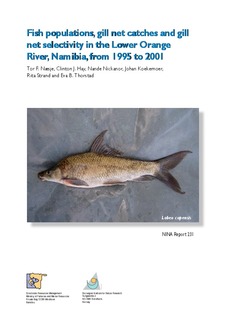Fish populations, gill net catches and gill net selectivity in the Lower Orange River, Namibia, from 1995 to 2001
Research report

Åpne
Permanent lenke
http://hdl.handle.net/11250/2449864Utgivelsesdato
2007Metadata
Vis full innførselSamlinger
- NINA Rapport/NINA Report [2341]
- Publikasjoner fra CRIStin - NINA [2364]
Sammendrag
Næsje, T. F., Hay, C. J., Nickanor, N., Koekemoer, J., Strand, R. and Thorstad, E. B. 2007. Fish populations, gill net catches and gill net selectivity in the Lower Orange River, Namibia, from 1995 to 2001. - NINA Report 231. 81 pp.
The White Paper “Responsible Management of the Inland Fisheries of Namibia” was finalised in December 1995, and forms the basis for the new Inland Fisheries Resources Act and Regulations concerning fish resources management in the different freshwater systems. All perennial rivers in Namibia are shared with neighbouring countries and also form large sections of the international borders between these countries. The effects on the resources of the subsistence, commercial and recreational fisheries in neighbouring countries must also be taken into consideration. Hence, successful management of the fish resources must be regionally orientated. When implementing fisheries regulations for such complex systems, information on the fish resources and their exploitation in the different water bodies is needed.
Based on a series of studies of the fish resources in the perennial rivers in Namibia, recommendations are given for management regulations of the fisheries in the different rivers. These management regulations are aimed at involving local, national and international authorities and stakeholders. It is a priority to secure a sustainable utilisation of the fish resources for the benefit of local communities and future generations. Important aspects of fisheries management have been studied to form the basis for new management strategies. Studies involve descriptions of the fish resources (Hay et al. 2000, 2002, Næsje et al. 2004, this report) and the exploitation of fish resources, including the socioeconomic infrastructure of local societies (Purvis 2001a, b, Næsje et al. 2002, Hay et al. in prep.), fishing competitions (Næsje et al. 2001), catch and release fisheries (Thorstad et al. 2004), and movement, migrations and habitat utilisation of important fish species (Økland et al. 2000, 2002, 2005, Thorstad et al. 2001, 2002, 2003a, b, 2005).
The studies of fish migrations conclude that certain fish species may migrate between countries, both laterally and longitudinally in these river systems, which emphasise the importance of joint local and regional co-management of the fish resources both on a national and international scale. Other species, however, are more stationary and, hence, more vulnerable to local exploitation. The biological and sociological aspects of the subsistence, semi-commercial and recreational fisheries have documented that in the absence of a strong formal system of fisheries management, the informal (or traditional) management component has remained in Namibia. However, there are strong calls from all levels for an improved and effective system for national and multinational fisheries management.
In the present report, the fish populations in the Orange River are described on the basis of five surveys performed in the period 1995 - 2001. The project is a collaboration between the Freshwater Fish Institute of the Ministry of Fisheries and Marine Resources (MFMR), Namibia, and the Norwegian Institute for Nature Research (NINA). The study has received financial support from the Norwegian Agency for
Development Cooperation (NORAD), the Ministry of Fisheries and Marine Resources in Namibia and the Norwegian Institute for Nature Research. Lower Orange River, Namibia, fish populations, management of fisheries, Ramsar site